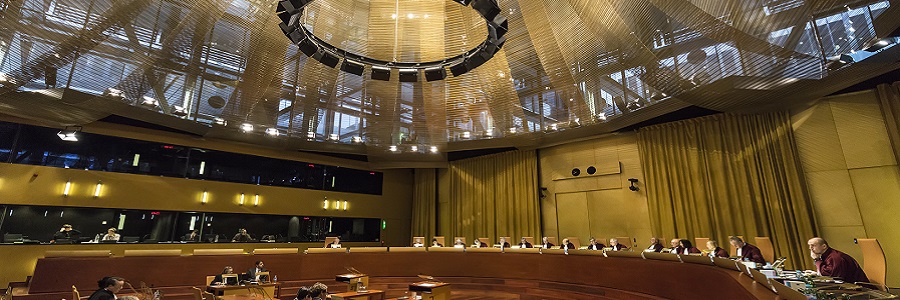Alix de Zitter
LERU Brexit Seminar
In March 2019, the United Kingdom (‘UK’) will become a ‘third country’ to the European Union (‘EU’). The relationship between the UK and the remaining 27 Member States (EU27) will veer from an integrated EU law-based system to a public international law-based system. Considering the large number of countries involved, their distinct social-economical interests and the importance of international trade between the UK and EU27, disagreements as to the scope and the meaning of any future trading agreements between the UK and EU27 are bound to happen. Therefore, a dispute resolution mechanism to solve disagreements on the correct interpretation and application of these agreements (‘Agreement’) will be required.
 © Court of Justice of the European Union
© Court of Justice of the European Union
At the time of the June European Council, the UK and EU27 had only reached a consensus on limited aspects of the dispute resolution mechanism set out in the draft Withdrawal Agreement. They agree on the necessity of attempting friendly dialogue among leaders and experts to prevent disputes and to arrive at a mutually satisfactory resolution of any matter that might affect their cooperation. They also agree that the only formal dispute resolution mechanism will be found in the procedures provided in the Agreement. Beyond Articles 160 and 161 of the draft Withdrawal Agreement, none of the other provisions on dispute resolution have received in-principle agreement. However, a combined reading of the recent UK Government White Paper on ‘The Future Relationship Between the United Kingdom and the European Union’, and the Draft Withdrawal Agreement proposed by the EU on 19 March 2018 clarifies how both parties envision dispute resolution post-Brexit.
Both the UK and EU27 have agreed on a three step dispute resolution procedure. The first step consists of an informal dialogue, which is now agreed. Second, if good faith negotiation between the parties fails to resolve a particular issue, the UK and EU27 both agree to bring the dispute before the Joint Committee. The Joint Committee would report to the Governing Body, which would set the general direction of the UK-EU27 relationship.
The intervention of an executive body to solve disputes is common under EU Association Agreement (‘AA’), which is the suggested model for the future governance of UK-EU27 relations. There is, however, very little specification as to the roles and powers of the Joint Committee. It could either be a form of non-binding mediation, or alternatively the Joint Committee could issue recommendations (whether binding or not).
The third step is where the two proposals greatly diverge. The White Paper suggests that when the Joint Committee was unable to solve the dispute between the parties after ‘a defined period of time’, which is not specified, ‘it would make sense in some cases’, which are again not specified, to refer the issue to ‘an independent arbitration panel’, with a decision binding on the parties. Dispute resolution by an independent arbitration panel is also common in AA. However, the White Paper remains vague on the composition of the arbitration panel, the criteria of access to it, and the decision process. On the other hand, the EU27’s Proposal offers an alternative that conflicts with a big ‘red line’ for the UK: the termination of the Court of Justice of the European Union (‘CJEU’) jurisdiction in the UK post-Brexit. Indeed, pursuant to the EU27’s Proposal, as an ‘appeals’ mechanism, both the Joint Committee and the parties will have to refer the dispute to the CJEU whose rulings ‘shall be binding’ on the EU and the UK. It is difficult to see how the acknowledgment of the CJEU’s continuing role can be reconciled with the UK’s red line. The UK does not completely reject the future role of the CJEU in post-Brexit disputes. The White Paper recognises that the role of the CJEU may still be critical when disputes between the UK and EU27 require an interpretation of ‘those EU rules to which the UK had agreed to adhere as a matter of international law’. However, it clearly reaffirmed that ‘the court of one party cannot resolve disputes between the two’.
At the time of writing, it remains unclear how the UK and EU27 will find a compromise on the role of the CJEU. Alternatives to the CJEU could included a binding form of arbitration to settle disputes between the parties. That said, there is little doubt that the EU27 will insist that the CJEU is the only competent interpreter of EU law, and that any dispute echoing EU law between the parties must be resolved by the CJEU. The role of the CJEU could lead to an impasse in the negotiations regarding the dispute resolution mechanism in the final Agreement. In these circumstances, the UK and EU27 would be left with the default mechanism for resolving their trade disputes through the complex and slow WTO system. That should be good enough incentive for both parties to find a solution.
 Alix de Zitter
Alix de Zitter
University of Oxford
Alix de Zitter is a DPhil Candidate in Law at the University of Oxford and a New College Roche Scholar. Her current research focuses on the interaction between public policy and international arbitration in the European Union.
Shortlink: edin.ac/2OxEhB0 | Republication guidance
Please note that this article represents the view of the author(s) alone and not European Futures, the Edinburgh Europa Institute or the University of Edinburgh.
 This article is published under a Creative Commons (Attribution-NonCommercial-NoDerivatives 4.0 International) License.
This article is published under a Creative Commons (Attribution-NonCommercial-NoDerivatives 4.0 International) License.

